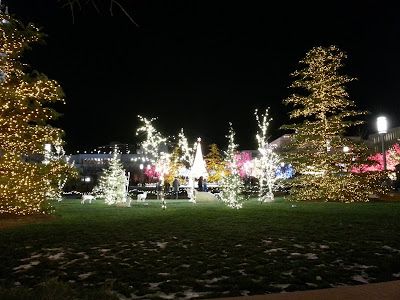Salt Lake City, UT
(genealogy research)
November 6, 2016 - December 12, 2016
Burr - it's been cold here for the last two weeks. We've even had snow and this is not in keeping with the number one rule we had when we started this trip - i.e. summers in the north and winters in the south. Luckily the Family History Library provides lots of opportunity to ignore the weather except when coming and going. One nice thing about the snow - it makes the mountains really stand out.
 |
| The mountains here are very close to the Salt Lake Valley. Great skiing is only about 45 minutes away. |
 |
| Christmas trees for sale at Whole Foods Store. The streaks are from snow - not rain. |
 |
| View from our campsite looking over towards the office. |
 |
| View from West Jordan, Utah |
 |
| Just another view of the beautiful mountains here. |
 |
| Barney - all snuggled up in Laura's robe. |
One of the things we like most about this campground is the large number of trees but that comes with it's own set of problems for the maintenance people. The scads and scads of leaves must be dealt with.
 |
| One day a crew of guys started work on the leaves. We think there were 5 people wielding leaf blowers... |
 |
| ...and a guy scooping up leaves and making big piles in various parking spots. |
 |
| There were probably 6-7 piles like this when they were finished. |
 |
| That's our motorhome just to the right of the tree in the foreground. |
 |
| For a while things looked pristine but as you can see - there were still leaves yet to fall so it didn't stay looking like this for very long. |
Thanksgiving came and went while we were here.
 |
| Luckily, little Roxie actually belongs to a fellow camper so we couldn't adopt her. The thought of stealing her did briefly cross our minds however. |
 |
| The story of Jesus's birth is narrated with special lighting and scenes depicting the event. This is the manger scene. Behind this scene is the Tabernacle where the Mormon Tabernacle Choir performs. |
 |
| The three wise men |
 |
| The Morman Temple in SLC. Neither the Temple nor it's immediate grounds are decorated. It's lit like this all year round. |
 |
 |
| This is the SLC Mormon church. The "pink" lights in this and the pictures below are actually red. |
 |
| This is the lobby in the Joseph Smith Memorial Building. The building was originally a hotel before the church bought it. As you can see - it's interior is very impressive. |
 |
| The ceiling in the lobby of the Joseph Smith Memorial Building. So beautiful! |
 |
| The Garden Restaurant in the Joseph Smith Building is famous for its Creme Brule! We ate dinner there after seeing all the lights just so we could have this for dessert. It was delicious! |































